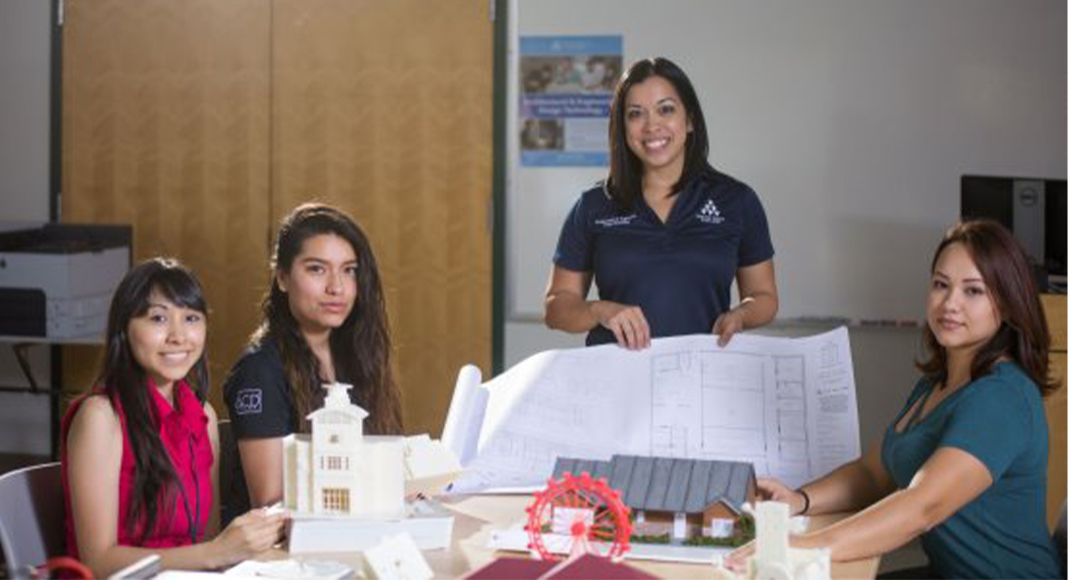
Texas Border Business
MCALLEN, TEXAS – While women have shattered some glass ceilings, other barriers are still a work in progress when it comes to a female-friendly workforce.
It may be hard to believe, but the U.S. Department of Labor still lists more than 100 occupations as “non-traditional careers” for women, which means 25 percent or less of those in the field are female. From computer programmers to engineers, these higher-paying careers have historically been harder for women to enter … unless they have outstanding support.
“South Texas College is committed to student success for all students, whether they are pursuing a non-traditional career or not,” says Sara Lozano, Dean for Business, Technology and Public Safety.
As a woman with a background in architecture who earned her bachelor’s degree from Yale, Lozano is a living testament to the power of education in overcoming gender barriers. She began her journey at STC as an Architectural & Engineering Design Technology (AEDT) instructor and has been opening doors for students ever since.
The AEDT field, in particular, has proved a challenge for women. More than 130 years ago, the first professional female architect, Louise Blanchard Bethune, set up shop in New York. Yet until the emergence of Title IX in 1972, the majority of American architecture schools refused to admit women. Even now, although nearly half of architect grads are women, only 17 percent of registered architects are female, according to the American Institute of Architects.
“One of the challenges students face when they pursue a non-traditional career is that there is often a certain stigma associated with that career about which gender should be pursuing it,” says Lozano.
Fortunately, having good role models can help students hurdle over outdated assumptions. At STC, instructors double as mentors, as they have often gone through the same struggles as their students. It’s not just about being supportive. It’s about having a successful role model that students can relate to and emulate.
According to the dean, “We have faculty, staff and administrators who set excellent examples and serve as primary role models of what success looks like for individuals in non-traditional career fields.”
Margarita Vanguelova, an AEDT Associate Professor at STC for over 14 years, is the perfect example. With a Master of Science in civil engineering from Bulgaria and rich work history from all over the world, the instructor is dedicated to opening new possibilities for all of her students.
“I am passionate about architecture and civil engineering and hope that more young women will choose to follow this career path,” says Vanguelova, who has made unlocking non-traditional fields for women her passion. “Our program’s female graduates are very successful as architectural or civil engineering technicians.”
With greater equality comes increased creativity, according to the instructor. She has seen dynamic diversity firsthand while working with professionals from all across the globe at an international company in New York. Says the instructor, “The free exchange of ideas and different perspectives were reflected in the great quality of the projects.”
When it comes to beating bias, women in architecture, engineering and construction have to debunk the old myth that only males are professionals. It’s a barrier that Vanguelova had to overcome herself:
“As a structural engineer, I have observed construction managers’ surprise that a woman will inspect the construction site and an initial skepticism of my expertise,” recalls Vanguelova, who was only too happy to prove them wrong.
Despite the challenges, the AEDT field offers edifying careers with growing opportunities, exciting specializations and stellar incomes. Architectural and civil drafters command a solid $55,510, on average, in Texas, while those who advance their education and become architects can build salaries up to $80,000 and beyond. For creative, tech-savvy individuals with problem-solving skills, constructing a career in AEDT is rewarding in more ways than one.
“We prepare our female graduates for overcoming these obstacles by instilling confidence in them,” says Vanguelova. In addition to intensive, workforce-relevant instruction, students also complete competitive internships with local firms as part of the program. These long-standing industry connections give STC students a leg up when it comes to building confident careers.
“All of this gives our graduates an advantage in the job market or in their future studies,” says the proud professor. In fact, she says that many alums reach out to their instructors after graduation to let them know just how much their STC foundation “put them ahead of their peers.”
In training to be architectural or civil engineering technicians, STC students master specialized software like AutoCAD, Revit and Civil 3D, as well as Adobe programs like Photoshop and Illustrator. They also create construction documents, practice 3D modeling and animation, and gain exposure to architectural photography.
And if cutting-edge 3D-printing, laser cutting and engraving facilities weren’t enough, many classes also use advanced virtual reality equipment. From designing models to reviewing and walking around plans in a 3D environment, students gain practical, high-tech skills used in virtually every firm. And in some courses, the tech is even used to take computer-simulated “field trips” to ancient cities.
“This technology is very useful for introducing designs to clients and for helping companies win contracts,” explains Vanguelova.
“We prepare our students with some of the latest technology,” adds Lozano. “They can leave our program not only employable but as innovators in their industry.”
For the dean, encouraging future technicians is all about turning a challenge into a tremendous opportunity. She says employers appreciate STC students who pursue non-traditional career fields because they display marked dedication and bring new perspectives to the industry.
“Once students graduate and begin looking for jobs, one of the benefits is that they are in demand because of the diversity they will bring to the field,” says Lozano. “Having women in non-traditional career fields opens doors for more opportunities to show that these career fields are not only limited to one gender.”
While old perceptions can be stubborn, Vanguelova is of a mind that “providing the community with correct information and organizing events promoting the career opportunities in these fields could make a difference.”
That’s why STC hosts several events to encourage women to level the playing field across non-traditional careers. The annual Women in Technology event, for example, showcases all the different programs in the Business, Public Safety and Technology division. It’s an engaging way to get the word out to “we can do it” women ready for the new workforce.
There’s also the She Persistscampaign, which draws upon the stories and achievements of female grads in non-traditional career fields to inspire current students. In the fall, AEDT students have the opportunity to attend the Building Communities Conferenceto network with design, building and construction professionals in local industries. Students also participate in lectures and connect with local branches of professional organizations, including the American Society of Civil Engineers and the American Institute of Architects.
“There are many great architects who happen to be women,” says Vanguelova, who considers creativity, innovation, teamwork, technical know-how, and most of all, hard work to be the most essential traits for an aspiring AEDT professional.
“The qualities of a good professional in the AEC industry are not gender-specific,” says the professor. “Gender should not be an issue.”













